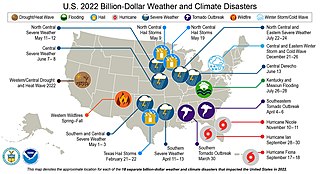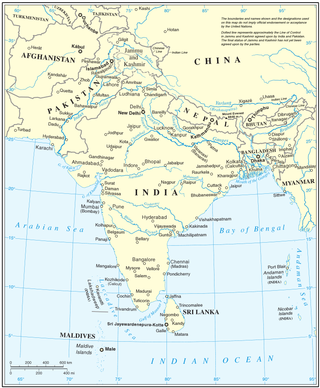
A cloudburst is an enormous amount of precipitation in a short period of time, sometimes accompanied by hail and thunder, which is capable of creating flood conditions. Cloudbursts can quickly dump large amounts of water, e.g. 25 mm of the precipitation corresponds to 25,000 metric tons per square kilometre. However, cloudbursts are infrequent as they occur only via orographic lift or occasionally when a warm air parcel mixes with cooler air, resulting in sudden condensation. At times, a large amount of runoff from higher elevations is mistakenly conflated with a cloudburst. The term "cloudburst" arose from the notion that clouds were akin to water balloons and could burst, resulting in rapid precipitation. Though this idea has since been disproven, the term remains in use.
Shadi Kaur Dam is a dam located on the Shadi Kaur river about 50 kilometres north of Pasni in Balochistan province of Pakistan. The dam, 485 metres long, was constructed in 2003 at a cost of 45 million Pakistani rupees ($758,853) to provide irrigation for nearby farms.

Schuld is a municipality in the district of Ahrweiler, in Rhineland-Palatinate, Germany, on the River Ahr.

A dam failure or dam burst is a catastrophic type of structural failure characterized by the sudden, rapid, and uncontrolled release of impounded water or the likelihood of such an uncontrolled release. Between the years 2000 and 2009 more than 200 notable dam failures happened worldwide.

Typhoon Morakot, known in the Philippines as Typhoon Kiko, was the deadliest typhoon to impact Taiwan in recorded history. The eighth named storm and fourth typhoon of the 2009 Pacific typhoon season, Morakot wrought catastrophic damage in Taiwan, killing 673 people and leaving 26 people missing, and causing roughly NT$110 billion (US$3.3 billion) in damages. Morakot originated as a tropical depression in the West Pacific on August 2. The system initially moved northeastward, before taking a westward track, developing into a tropical storm on August 3, with the JMA giving it the name Morakot. The storm gradually strengthened as it moved towards Taiwan, intensifying into a Category 1-equivalent typhoon on August 5. Morakot reached its peak intensity on August 7, with a minimum central pressure of 945 millibars (27.9 inHg), maximum 10-minute sustained winds of 140 km/h (85 mph), and maximum 1-minute sustained winds of 150 km/h (90 mph). Afterward, Morakot's forward motion slowed and the system gradually weakened, making landfall on central Taiwan later that day as a severe tropical storm. Over the next day, Morakot slowly meandered over Taiwan, before emerging into the Taiwan Strait and turning northward, making landfall on Mainland China on August 9. Afterward, Morakot accelerated northward while gradually weakening, before later turning northeastward. On August 11, Morakot degenerated into a remnant low in the East China Sea, before dissipating on August 13, over northern Japan.

The 2010 China floods began in early May 2010. Three hundred and ninety-two people died, and a further 232 people were reported missing as of June 30, 2010, including 57 people in a landslide in Guizhou. Fifty-three of the deaths occurred from the flooding and landslides between May 31 and June 3, and 266 deaths occurred between June 13 and June 29. Four hundred and twenty four people were killed by the end of June, including 42 from the Guizhou landslide; 277 more were killed and 147 were missing in the first two weeks of July, bringing the death toll as of August 5 to 1,072. A landslide in early August in Gansu killed at least 1,471 people and left 294 missing. In total, the flooding and landslides killed at least 3,185 people in China by August 31. More than 230 million people in 28 provinces, municipalities, and regions, especially the southern and central provinces and regions of Zhejiang, Fujian, Jiangxi, Hubei, Hunan, Guangdong, Guangxi, Chongqing Municipality, Gansu, Sichuan, and Guizhou, and the northeastern province of Jilin were affected, while at least 4.66 million people were evacuated because of the risk of flooding and landslides in the latter half of June. By early August, over 12 million people were evacuated, and that number rose to 15.2 million by August 31.

The 2010 Ladakh floods occurred on 6 August 2010 across a large part of Ladakh, then part of the state of Jammu and Kashmir. 71 towns and villages were damaged, including the main town in the area, Leh. At least 255 people are reported to have died, six of whom were foreign tourists, after a cloudburst and heavy overnight rains triggered flash floods, mudflows, and debris flows. 200 people were reported missing in the initial aftermath of the storm, and thousands more were rendered homeless after the flooding caused extensive damage to property and infrastructure. Overall, 9,000 people were directly affected by the event.
The 2011 China floods were a series of floods from June to September 2011 that occurred in central and southern parts of the People's Republic of China. They were caused by heavy rain that inundated portions of 12 provinces, leaving other provinces still suffering a prolonged drought, and with direct economic losses of nearly US$6.5 billion.

Tropical Storm Kai-tak, known in the Philippines as Tropical Storm Urduja, was a late-season tropical cyclone that affected the Philippines during December 2017. The twenty-sixth named storm of the 2017 Pacific typhoon season, Kai-tak started as a tropical depression near Palau on December 11. After slowly intensifying, the system became a tropical storm on December 14. Due to its slow motion, Kai-tak made landfall in Samar on December 16 and traversed the Philippine Islands. Kai-tak later moved in a west-southwestward direction until it dissipated on December 23 near Malaysia.

The following is a list of weather events that occurred in 2021. The year began with La Niña conditions. There were several natural disasters around the world from various types of weather, including blizzards, cold waves, droughts, heat waves, tornadoes, and tropical cyclones. In December, powerful Typhoon Rai moved through the southern Philippines, killing 410 people and becoming the deadliest single weather event of the year. The costliest event of the year, and the costliest natural disaster on record in the United States, was from a North American cold wave in February 2021, which caused $196.4 billion (USD) in damage; the freezing temperatures and widespread power outages in Texas killed hundreds of people. Another significant natural disaster was Hurricane Ida, which struck southeastern Louisiana and later flooded the Northeastern United States, resulting in $70 billion (USD) in damage. December saw two record-breaking tornado outbreaks, only four days apart from each other. In Europe, the European Severe Storms Laboratory documented 1,482 weather-related injuries and 568 weather-related fatalities. The National Oceanic and Atmospheric Administration documented 796 weather-related fatalities and at least 1,327 weather-related injuries in the United States and the territories of the United States.

In July 2021, several European countries were affected by severe floods. Some were catastrophic, causing deaths and widespread damage. The floods started in the United Kingdom as flash floods causing some property damage and inconvenience. Later floods affected several river basins across Europe including Austria, Belgium, Croatia, Germany, Italy, Luxembourg, the Netherlands, and Switzerland. At least 243 people died in the floods, including 196 in Germany, 43 in Belgium, two in Romania, one in Italy and one in Austria.

The following is a list of weather events that occurred on Earth in the year 2022. The year began with a La Niña. There were several natural disasters around the world from various types of weather, including blizzards, cold waves, droughts, heat waves, wildfires, floods, tornadoes, and tropical cyclones. The deadliest weather event of the year were the European heat waves, which killed over 26,000 people, 11,000 of which were in France. The costliest weather event of the year was Hurricane Ian, which caused at least $112.9 billion in damages in Florida and Cuba. Another significant weather event was the Pakistan floods, which killed 1,739 people and a total of $14.9 billion in damages.

Throughout 2022, floods affected most of Africa, killing over 2,100 people. The worst affected country was Nigeria, with over 610 deaths.
Korea has historically suffered several floods due to heavy rains, typhoons, and heavy snowfalls. Most of the flood damage was caused by storms and tsunamis caused by typhoons, and floods.

From January to October 2022, excessive rainfall and widespread monsoon flooding occurred in the South Asian countries of Afghanistan, Bangladesh, India, Nepal, Pakistan, and Sri Lanka. It has become the region's deadliest floods since 2020, with over 4,700 people dead.

In October 2022, Crete, the largest island of Greece was hit by destructive floods. The floods were triggered by a large thunderstorm and heavy rains. Two fatalities were reported along with 150 millimetres (5.9 in) of rain falling within less 12 hours.

The following is a list of weather events that occurred on Earth in the year 2023. The year saw a transition from La Niña to El Niño, with record high global average surface temperatures. There were several natural disasters around the world from various types of weather, including blizzards, cold waves, droughts, heat waves, wildfires, floods, tornadoes, and tropical cyclones. The deadliest weather event of the year was Storm Daniel, which killed over 5,900 people, with most of the fatalities coming from Libya. The costliest weather event of the year was Typhoon Doksuri, which caused $28.5 billion in damages in China, the Philippines and Taiwan. Another significant weather event was Cyclone Freddy, which became the longest lasting tropical cyclone on record, beating the previous mark of Hurricane John in 1994. The storm caused 1,434 fatalities, with most of the deaths coming from Malawi.














